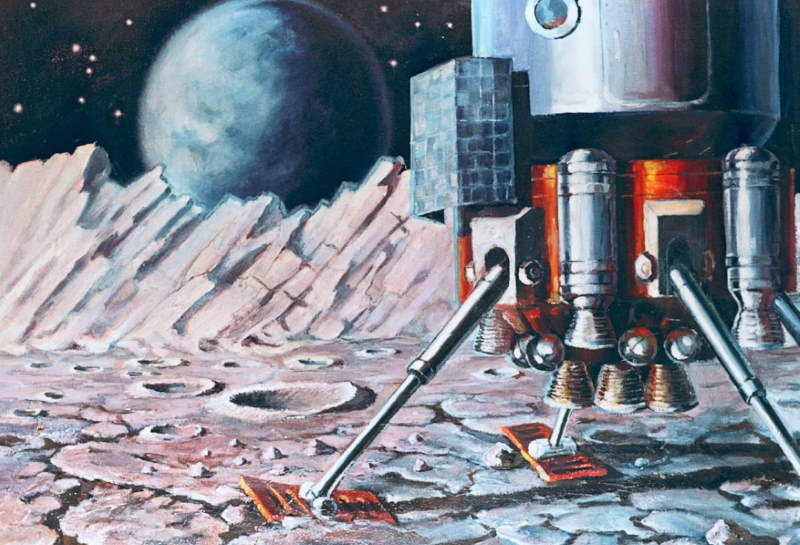Soviet and Russian cosmonaut Alexei Leonov (30 May 1934 – 11 October 2019), the first human to walk in space was also a painter.
Leonov painted scenes from humanity’s space exploration (both future and contemporary). He also painted his own spacewalk, which was the first in history.
On March 18, 1965, he has stepped out of the Voskhod 2 spacecraft into the void of space and became the first spacewalker ever. The spacewalk was successful despite the fact that it was teetering on the edge of a disaster from the moment Leonov stepped out of the airlock till the crew was rescued from the vast frozen forests of northern Russia.
The story of Leonov’s spacewalk was told by the 2017 Russian film “The Spacewalker”.
Alexei Leonov, an artist and a cosmonaut

Leonov was interested in art at an early age. in 1936, his father was arrested and declared an “enemy of the people”. So, he used art as a way to provide more food for the family. He began his art career by drawing flowers on ovens and later painted landscapes on canvasses.
Leonov wrote in his autobiography:
“He was not alone: many were being arrested. It was part of a conscientious drive by the authorities to eradicate anyone who showed too much independence or strength of character. These were the years of Stalin’s purges. Many disappeared into remote gulags and were never seen again.”
The family moved in with one of his married sisters in Kemerovo. His father rejoined the family in Kemerovo after he was released. He was compensated for his wrongful imprisonment.
Leonov could even have dedicated his life to art, but the aspiring artist from a poor rural household could not afford the studies. He applied to the Academy of Arts in Riga, Latvia, but decided not to attend due to the high tuition costs. So, he joined the military instead. He was one of the 20 Soviet Air Forces pilots selected to be part of the first cosmonaut training group in 1960, together with Yuri Gagarin, who would later become world-famous as the first human in space.

He was an accomplished artist whose published books include albums of his artistic works and works he did in collaboration with his friend Andrei Sokolov (1931-2007). Leonov took colored pencils and paper into space, where he sketched the Earth and drew portraits of the Apollo astronauts who flew with him during the 1975 Apollo-Soyuz Test Project.
Leonov had personally met the Spanish painter, sculptor, printmaker, ceramicist, and theatre designer Pablo Picasso (1881-1973) and inspired the English science-fiction writer Arthur C. Clarke (16 December 1917 – 19 March 2008), the author of “2001: A Space Odyssey”, to name the spaceship in the sequel after him.
Clarke dedicated 2010: Odyssey Two to Leonov and Soviet nuclear physicist Andrei Sakharov (21 May 1921 – 14 December 1989), and the fictional spaceship in the book is named Cosmonaut Alexei Leonov.
In 2004, Leonov and former American astronaut David Scott began work on a dual memoir covering the history of the Space Race between the United States and the Soviet Union. Titled Two Sides of the Moon: Our Story of the Cold War Space Race, the book was published in 2006. Neil Armstrong and Tom Hanks, who played Commander Jim Lovell in the 1995 movie Apollo 13, both wrote introductions to the book.
Leonov died on 11 October 2019 after a long illness in Moscow. He was 85 and the last living member of the five cosmonauts in the Voskhod programme.
Some of Leonov’s 200 space exploration-themed paintings are exhibited in the Tretyakov Gallery in Moscow, and also in galleries in Huston, the U.S., and Dresden, Germany, as well as in other cities.

Sources
- “Space Art by Alexei Leonov” on the Weird Russia website
- “Space Oddity: 8 paintings by the first man in outer space” on the Russia Beyond website
- Alexei Leonov on Wikipedia
- Space Shuttle Endeavour’s Touchdown Meets Columbia’s Salute [An amazing photo from the past] - February 29, 2024
- Moon Landings: All-Time List [1966-2024] - February 23, 2024
- From Orbit to Ordinary: 10 Earthly Applications of Space Technology - January 23, 2024


